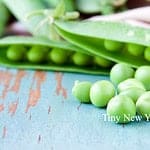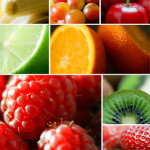Probably the first vegetable to be cultivated by man, ancient peas and beans have been found in settlements from the late Stone Age onwards (nearly 8,000 years ago). They are a highly nutritious vegetable, containing essential carbohydrates and proteins, as well as useful supplies of vitamins and minerals. They were particularly valuable to ancient man as they could be dried and stored, which meant that food was available throughout the year.
Garden Peas: These are one of the delights of summer, although they are one of those vegetables that are best when absolutely fresh. Pick your own (if you don’t grow them yourself) is the best way to enjoy peas at their best. There are many varieties of peas, some of which can be eaten whole, including the pod. Peas are one of the few vegetables that taste almost as good when frozen. Because freezing takes place soon after picking, frozen peas often have a higher nutritional content than fresh, and are available all year round.
Mangetouts: These are eaten whole and are valued for their pods, rather than the peas, which never mature. Mangetouts have a delicate, sweet flavor. To prepare, young, freshly picked mangetouts simply need to be topped, tailed, and washed. They should be cooked only briefly to retain their delicate, mild flavor and crisp bite. They can be blanched or stir-fried and are also good served raw in salads.
Petits Pois: These are not, as you might expect, immature peas, but are a dwarf variety. They are wonderfully tender and have a sweet, delicate flavor. Gardeners grow their own, but petits pois are not widely available fresh in the shops as they are mainly grown commercially for canning or for freezing.
Snow Peas/Sugar Peas/Sugar Snap Peas: These have the distinct fresh flavor of raw peas and are plumper and have more “snap” than mangetouts. They are delicious added raw to salads. They are also good steamed or boiled, but should only be cooked for about 1 minute or they will lose their wonderful flavor and texture.
Buying And Storing: Only buy really fresh peas. If they are old they are bound to be disappointing. In top condition, the pods are bright green and lively looking. The more withered the pod, the longer ago they were picked. Use fresh peas as soon a possible.
www.tinynewyorkkitchen.com
“Work With What You Got!”
© Victoria Hart Glavin Tiny New York Kitchen © 2017 All Rights Reserved
Have you ever come home from the market after purchasing fruit to find that you spent money for nothing? I have plenty of times and it ticks me off every time. Here are some Fruit Essentials that may help you have more fruit shopping success.
Did you know that many plants that are botanically fruits are not sweet? We think of them as vegetables or non-fruits. Avocados, beans, coconuts, corn, cucumbers, eggplants, green peppers, okra, peas, pumpkins, sugar peas, string beans and tomatoes all fall in the fruit category. Some cookbooks make a distinction between fruit, vegetables and fruit vegetables. Fruit vegetables are foods that are botanically fruits, but are most often prepared and served like vegetables. These fruits are considered fruit vegetables: Aubergine, autumn squash, avocado, bitter melon, cantaloupe, chayote, chile, courgette, cucumber, eggplant, gherkin, green bean, green sweet pepper, hot pepper, marrow, muskmelon, okra, olive, pumpkin, red sweet pepper, seedless cucumber, squash, sweet pepper, tomatillo, tomato, watermelon, wax gourd, yellow sweet pepper and zucchini.
Pectin is a substance contained in some fruit which is used for making jams and jellies thicker. High pectin fruits are apples, cranberries, currants, lemons, oranges, plums and quinces. Low pectin fruits are bananas, cherries, grapes, mangos, peaches, pineapples and strawberries.
Low pectin fruits seem to discolor quicker than high pectin fruits ( bananas and eggplants). Lemon juice or vinegar slows the discoloring process. Other fruits and vegetables that discolor quickly are avocados, cauliflower, celery, cherries, figs, Jerusalem artichokes, mushrooms, nectarines, parsnips, peaches, pears, potatoes, rutabaga and yams.
Bruising: When a fruit is bruised the cell walls break down and discoloration begins. The process can be slowed down by refrigeration.
Cleaning: It is important to clean our fruit and vegetables. Rinse fruit in cold running water and scrub as needed before cooking or eating. Soaking fruit in water for more than a few minutes can leach out water soluble vitamins.
Peeling: The fruit skin usually contains a lot of important nutrients, but if you need to peel a thick-skinned fruit cut a small amount of the peel from the top and bottom. Then on a cutting board cut off the peel in strips from top to bottom. A good way to peel thin skinned fruit is to place the fruit in a bowl with boiling water and let stand for about 1 minute. Remove and cool in an ice water bath. You could also spear the fruit with a fork and hold over a gas flame until the skin cracks OR quarter the fruit and peel with a sharp paring knife or potato peeler.
Wax: Oh those beautiful waxed apples that wink at us at the market. They are beautiful because they are waxed. I don’t know about you, but I would rather not eat wax. Wax can be removed from the surface of fruits by washing them with a mild dishwashing soap and then thoroughly rinsing them. This will remove most of the wax, but probably not all of it.
Purchasing Ripe: Purchase these fruits fully ripe: Berries, cherries, citrus, grapes and watermelon. All of the fruits in this list, except berries, can be refrigerated without losing flavor.
Purchasing Not-So-Ripe: Apricots, figs, melons, nectarines, peaches and plums develop more complex flavors after picking. Store these fruits at room temperature until they are as ripe as you would like them.
Refrigeration: You can refrigerate apples,ripe mangos and ripe pears as soon as you get them. Do not refrigerat bananas.
Seasonal Fruit: Winter is the season for citrus. Fall is the season for apples and pears. Late spring is the season for strawberries and pineapples. Summer is perfect for blueberries, melons, peaches and plums.
Washing: Dry fruit with paper towels or kitchen towels and then use a blow dryer on the cool setting to completely dry fruit.
Squeezing: A microwave can be used to get more juice from citrus fruits. Microwave citrus fruits for about 20 seconds before squeezing the fruit for juice.








